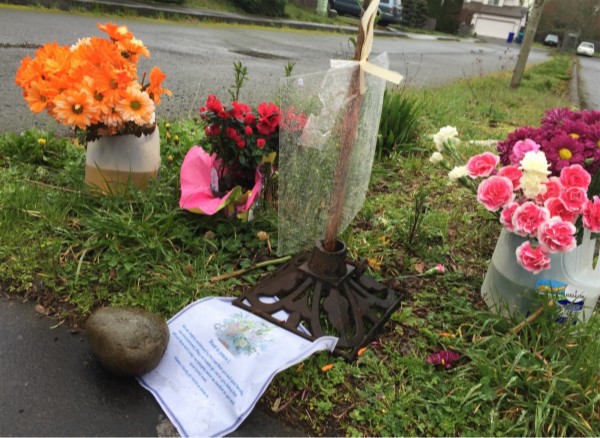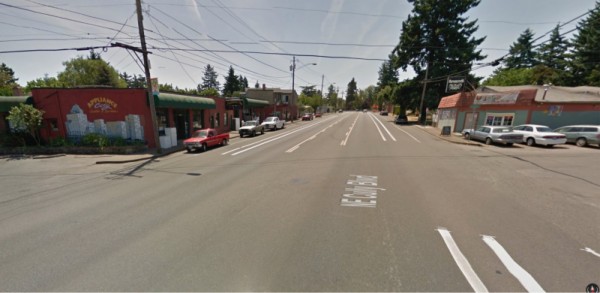
(Photos: J. Maus/BikePortland)
In less than 24 hours between Friday and Saturday three people were hit while using Portland streets without a car. Two of them died and another person is hospitalized with life-threatening injuries. In both fatalities, Police made an arrest for drunk and reckless driving.
This is a wake-up call for Portland, a city that has embraced “Vision Zero” and made a very public commitment to get serious about street safety.
Mayor Charlie Hales and Steve Novick released a statement this morning to reiterate that committment and to “urge the public to take steps to reduce crashes.” Hales warned against the dangers of drunk driving and Novick, who leads the Bureau of Transportation, said “Clearly we need to do more.” “I remain firmly committed to improving transportation safety, especially in areas such as East Portland, where historically underserved communities brave some of our city’s most dangerous roadways,” Novick said.
I visited both sites this morning.
Cully and Mason: A well-known danger spot
The man who was killed here just after 11:00 pm on Saturday night was 58-year-old Patrick Curry. He was trying to cross Cully at Mason. According to police, 29-year-old William Hurst was driving southbound on Cully when he struck Curry. A man who works at Appliance City on the southeast corner of the intersection told me Curry’s wife is a bartender at Spirits bar (on the right in the photo above).
“I am left feeling that I should have done more.”
— David Sweet, Cully Association of Neighbors
This section of Cully is one of those streets that everyone seems to know is very dangerous yet little has been done to make it safer (this happened just a few blocks north south of where the City installed Portland’s first protected cycle track in 2011). When I asked the man who works at City Appliance about the street conditions he said, “It’s Cully! Everybody flies through here. It’s big and wide and everybody speeds.” A woman who works at Sprits bar said, “This street is really dangerous. People get hit here all the time. It’s notorious.”
Cully is 85-feet wide at this location and the posted speed limit is 35 30 miles per hour (lowered from 35 a few years ago). Because there’s only one standard lane next to a wide center turn lane, a bike lane, and a parking lane on both sides, it feels very wide and open. Along with the high speeds on Cully, Mason crosses at an angle and sight lines are poor. Next to this intersection is light commercial density (a bar, a body shop, an appliance repair place) next to low-density residential.
In 2013 a Cully neighborhood resident made a formal request to the City of Portland to improve this crossing. The City investigated the request and determined the location was too dangerous for a marked crossing because “in part due to the drivers who are not aware of the marked crossing and the pedestrians who feel a sense of security with the markings,” a PBOT engineer said at the time. The City will only improve this crossing if it can come with a median refuge island and some sort of beacon and/or signal. And neighbors were told in 2013 that that’s just too expensive.
Cully Association of Neighbors land-use chair David Sweet emailed us to share the neighborhood’s concerns. “Cully Boulevard is structurally unsafe,” he said, “The wide street encourages speeding and increases crossing time. The curve south of Mason obscures visibility for northbound drivers. The sidewalks are narrow, curb-tight, and non-continuous. The bike lanes need protection.” Sweet is frustrated because he says PBOT has pushed back the timeframe for a host of safety updates to Cully Boulevard. “Originally slated for a 1-10 year timeframe, it was pushed back to the 11-20 year timeframe in revisions to the [Transportation System Plan] list last summer,” Sweet said. “The explanation I received was that other parts of Cully Boulevard were improved just a few years ago and we should spread the wealth.” Following Curry’s death, Sweet has drafted a new letter to send to PBOT officials and will seek endorsement of it at the neighborhood association meeting tomorrow night.
“I am left feeling that I should have done more,” Sweet added.
Advertisement
Quiet Center Street an uncommon place for traffic tragedy

Austin Hrynko was just 17 years old. He was biking westbound on Center Street just east of 141st in broad daylight on Saturday. Other kids were out and about on a beautiful spring day. 55-year-old Frank Drobny was going in the opposite direction and, for some reason we don’t know of yet, he turned left in front of Hrynko and the two collided. Drobny was turning into a cul-de-sac driveway where he lives. Witnesses told TV news crews he didn’t even try to stop.
Fatal crashes aren’t supposed to happen on streets like this. It was raining this morning and I still saw several families in the area. One woman was driving by and stopped her mini-van right in the middle of the road, got out, and walked over to a small memorial of flowers placed near the collision point. She didn’t know what had happened but saw me and the flowers and was curious. I told her a boy was killed while biking and she looked at me with absolute horror. “Here?! Biking?! I have many small children….” She didn’t speak much English but it was clear she was shocked at the news.
There are speed bumps on the street, but they don’t do a very good job of slowing people down. This morning while being interviewed by KGW, several people zoomed by way faster than they should have been going.
Fortunately in both of the fatal collisions, the person driving the car was quickly arrested and booked with serious charges of Reckless Driving, DUII and Manslaughter II. Even if justice is ultimately served, these senseless and preventable tragedies will never be forgotten by the families and friends of those involved. Our thoughts are with them. Now we must return to taking direct actions to end this cycle of traffic violence. Everyone can and should do something to stop it.
More coverage: KOIN-TV Groups outraged by preventable auto-ped crashes.
CORRECTION, 3/22 at 8:55 am: This post originally stated that the Cully Association of Neighbors made the request to the City of Portland for a safer crossing at Mason in 2013. That was incorrect. A private resident made that request.
— Jonathan Maus, (503) 706-8804 – jonathan@bikeportland.org
BikePortland can’t survive without subscribers. It’s just $10 per month and you can sign up in a few minutes.

